Indoor Lighting Solutions for a Serene Bedroom
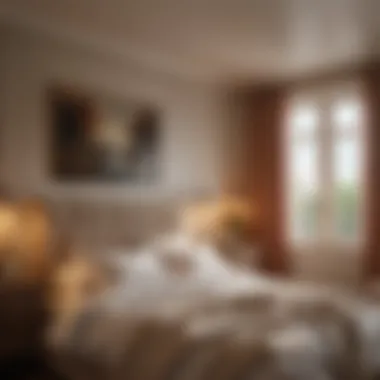
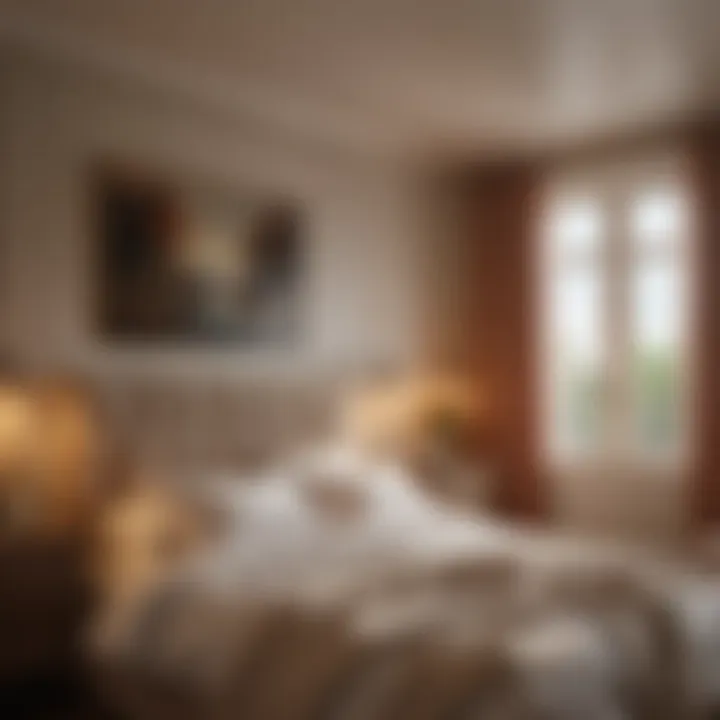
Intro
When it comes to creating a bedroom that feels inviting and looks aesthetically pleasing, the type of lighting you choose plays a substantial role. Lights aren't just functional; they can change the entire mood of a space. A well-lit room can make a small space feel expansive or turn a mundane area into a cozy retreat.
There are myriad options available today, ranging from modern LED fixtures to vintage-inspired lamps, all catering to different tastes and needs. Selecting the right indoor lights for your bedroom is more than just picking out pretty fixtures—it's about enhancing the comfort and functionality of your environment.
In this guide, we'll dive into the current trends in bedroom lighting, explore various lighting options, and provide strategic placement tips. Each section is designed to offer insights that consistently aim for a serene and restorative bedroom environment.
Current Trends
As the world of interior design continues to evolve, lighting trends follow suit. Here are key aspects influencing contemporary bedroom lighting today:
Color Palettes
When thinking about lighting, one cannot overlook its color temperature. A warm white light, ranging between 2700K and 3000K, usually fits well in bedroom settings, fostering a sense of coziness and tranquility. Meanwhile, cooler lights can be beneficial for tasks or reading areas. Depending on your style, incorporating dimmable options or smart bulbs can tweak the ambiance to match your mood or time of day.
Popular Styles
Recent trends show a growing popularity in minimalist designs and industrial vibes. Here are a few styles that are really capturing attention:
- Scandinavian: Known for its simplicity and functionality, this style often includes soft, muted lights that complement neutral palettes.
- Rustic: Incorporating reclaimed wood and iron fixtures brings a sense of warmth and nature into the space.
- Modern Glam: Shine bright with chandeliers and luxurious bulbs for a glam touch that adds drama without overwhelming.
Incorporating these styles into your lighting choices can help in creating a well-curated space, while with color choices resonates with your unique preferences.
"Lighting is not only functional; it's an artistic expression that influences the feel of your entire home."
Visual Ideas
To further inspire your lighting choices, visual examples can help in picturing your ideal setup. Considering the impact of lighting, let’s walk through a spectrum of options.
Gallery of Styled Bedrooms
Imagine a tranquil bedroom with soft ambient lights illuminating a pathway to your nightstand—a serene scene that promotes relaxation. Alternatively, a bold statement lamp sitting on a desk invites creativity into the space. Here are some common setups:
- Layering: Mix overhead lights, wall sconces, and table lamps.
- Focus: Use spotlights or track lighting to emphasize art or decor pieces.
Before-and-After Transformations
Enhancements in lighting can truly transform a space, turning a once-drab room into a chic sanctuary. Consider a dimly lit room flooded with natural light during the day, contrasted with soothing pendant lighting for the evening. The before-and-after effect can show just how lighting can shift a room’s vibe dramatically.
Understanding the Importance of Bedroom Lighting
Bedroom lighting is more than just a practical necessity; it’s a pivotal element that deeply influences the atmosphere and functionality of the space. A carefully curated lighting scheme can transform a basic room into a cozy haven or an energizing retreat, depending on the desired effect. It’s crucial to grasp the significance of bedroom lighting as it plays a vital role in enhancing our daily routines, being pivotal for relaxation, productivity, and comfort.
Psychological Effects of Lighting
Influence on Mood and Emotions
Everyone knows that light can impact how we feel. Different types of lighting can evoke various emotions. For instance, warmer tones can create a feeling of coziness and tranquility. When you step into a dimly lit room with soft, amber lights, it’s like a warm embrace after a long day. In contrast, brighter, cooler lights can stimulate alertness and may even raise your energy levels, making them suitable for tasks like reading or working late into the night.
The key to harnessing this effect lies in understanding that the right light can shape our mood almost effortlessly. A mood-enhancing lighting scheme can be as simple as implementing dimmer switches or incorporating a variety of light sources. This versatility offers significant advantages for creating a versatile space that adapts to different activities or feelings.
However, it’s important to remember that not all lighting promotes a positive mood. Harsh fluorescent lights, for instance, are well-known for causing discomfort and potentially elevating stress levels. When thinking about the atmosphere of your bedroom, opting for softer, more natural lighting can significantly boost your sense of well-being.
Impact on Sleep Patterns
The relationship between lighting and sleep is something that shouldn't be taken lightly. Exposure to bright blue light, typically emitted by electronic devices, can disrupt our natural circadian rhythms, interfering with the body's readiness to rest. Bedrooms designed with appropriate lighting can help signal your body when it’s time to wind down. You might want to consider using warm-toned bulbs or bedside lamps that can be dimmed to create a calming environment.
The unique feature here is that light can train your body when to produce melatonin, the sleep hormone, thus playing a crucial role in both the quality and quantity of your sleep. A well-thought-out bed light setup, like using adjustable bedside lamps that emit a gentle glow, can have substantial advantages for those struggling with sleep issues.
Functional vs. Aesthetic Lighting
Balancing Practicality and Style
Finding the sweet spot between functionality and aesthetics is no easy feat, yet it is essential. Practical lighting ensures you can partake in daily activities without straining your eyes, but it shouldn’t overshadow the aesthetic elements of your bedroom either. The balance you strike here can truly elevate the entire environment.
For example, incorporating stylish fixtures, such as sleek pendant lights that also serve as effective task lighting, merges both worlds effortlessly. Yet, it’s important to consider how a light’s style harmonizes with the room’s overall decor. Too bold of a design can clash rather than complement, creating visual chaos rather than serenity.
Defining Space with Light
Effective lighting can also help define various areas within your bedroom, creating distinct atmospheres for different uses. This strategic aspect of lighting is beneficial, especially in smaller bedrooms where boundaries between spaces aren’t as clear.


Using accent lights to highlight certain corners, or maybe even a reading nook, will personalize your space. Not only does this tackle the functional aspect, helping to avoid confusion about where to focus your energy, but it also adds an aesthetic charm. You can use spotlights to emphasize artwork or architectural details; this not only draws the eye but also enhances the room’s character.
Types of Indoor Lighting for Bedrooms
When it comes to creating a comfortable and inviting bedroom, lighting plays a pivotal role. Different types of indoor lighting can set the mood, enhance functionality, and highlight architectural features. Understanding the various types of lighting—ambient, task, and accent—allows homeowners to tailor their spaces according to personal preferences and specific needs. Choosing the right mix of lighting can transform the bedroom from a simple sleeping area into a multi-functional retreat that balances aesthetics with practicality.
Ambient Lighting
Definition and Examples
Ambient lighting serves as the foundation of any room's illumination. It provides general, even light throughout the bedroom, allowing for movement and comfort without harsh shadows. Common examples include ceiling fixtures, recessed lights, and chandeliers. These options not only brighten the room but also can add a touch of style. A key characteristic of ambient lighting is its ability to create a warm atmosphere, making it an ideal choice for those who retreat to their bedroom to relax at the end of the day.
While ambient light is vital, its effectiveness can vary based on fixture type and placement. For instance, a dimmable ceiling fixture can adjust brightness according to the time of day or mood. However, too much reliance on a single source can lead to a flat and uninviting space.
Best Fixtures for Ambient Light
When selecting fixtures for ambient lighting, consider options like flush mount lights or pendant lamps. It's essential to choose fixtures that align with your room's height and style. For low ceilings, flush mounts maximize headroom, whereas a striking pendant light can serve as a statement piece in a larger room. The best ambient lights strike a balance between functionality and visual appeal.
An advantage of modern fixtures, particularly LED options, is their energy efficiency, allowing for extended use without significant increases in utility bills. Conversely, outdated or overly ornate fixtures can feel heavy-handed, cramping the overall design of a bedroom.
Task Lighting
Choosing the Right Task Lights
Task lighting is geared towards providing focused illumination where it’s needed most. Reading lamps beside the bed or lit mirrors can significantly enhance everyday activities. This type of lighting is essential for activities like reading, working on a laptop, or applying makeup. A vital consideration when selecting task lights is their adjustability, which should allow for light direction.
For instance, a swinging arm lamp can direct light wherever it’s needed, offering flexibility. Task lighting fixtures should also coordinate well with ambient lighting to maintain a cohesive look. Yet, it's worth noting that too bright or poorly positioned task lights can create glare and become uncomfortable.
Placement Strategies
Where you place your task lights drastically affects their utility. Ideally, bedside lamps should allow for easy access without taking up valuable nightstand space—think wall-mounted or clamp styles. Effective placement takes into account both functionality and aesthetic harmony with ambient lighting.
For workspaces within the bedroom, adjustable desk lamps can provide focused task lighting. However, remember that poorly placed fixtures can lead to visual clutter or create dark spots in the room.
Accent Lighting
Highlighting Features and Decor
Accent lighting is the icing on the cake; it's used to highlight artwork, architectural features, or to create a focal point in the room. This type of illumination adds a sophisticated flair and depth to space, making it feel more curated. Its primary function is to enhance the beauty of specifics, rather than to provide overall light.
For example, a spotlight can shine on a beautiful piece of art, enhancing the visual appeal of the room. On the downside, if overused, accent lights might draw attention from the space’s intended focal points or create an overwhelming effect, disrupting the overall ambiance.
Types of Accent Lights
There are several types of accent lights, including track lighting, wall-mounted picture lights, and floor-mounted uplights. Each serves a distinct purpose and can be tailored to the specific needs of your bedroom decor. The best accent lights not only showcase design elements but also contribute to an overall warm atmosphere.
Consider using adjustable fixtures to create varied effects, like illuminating different artworks or adjusting the intensity of light based on time and occasion. However, be cautious—too many accent lights scattered throughout can lead to a cluttered effect rather than an elegant display.
In summary, understanding the three main types of indoor lighting is crucial when designing a bedroom that meets both aesthetic and practical needs. By thoughtfully considering ambient, task, and accent lighting, one can craft a space that is not only comfortable but also visually impressive.
Selecting the Right Fixtures
Selecting the right fixtures is crucial because they play a significant role in both the functionality and aesthetic of your bedroom lighting. Proper fixtures can set the tone for the space, influencing how you feel when you walk in. They provide necessary illumination for tasks like reading or getting dressed, yet they also shape the mood when you unwind at the end of the day. The key considerations include ensuring that the fixtures fit well within the room's layout, personal style, and usage needs.
Ceiling Lights
Different Styles and Their Uses
When it comes to ceiling lights, you might stumble upon a variety of styles ranging from chandeliers to flush mounts and pendant lights. Each style has its own unique flair and serves different practical purposes. For instance, a low-profile flush mount can be a great space-saver, particularly in rooms with lower ceilings. In contrast, a pendant light adds character and can act as an eye-catching focal point in a room where ceiling height permits.
A key characteristic of ceiling lights is their ability to provide ambient lighting, which helps in creating a warm atmosphere while also illuminating the entire room.
**"Choosing the right ceiling fixture can significantly enhance the perception of space versus cramping it."
Another benefit is that many modern ceiling lights come with energy-efficient options, helping your pocket in the long term. However, a downside could be the initial installation costs and the need for proper placement for effective lighting.
Height and Scale Considerations
Height and scale considerations are vital when selecting ceiling lights. It's important to consider how high your ceilings are relative to your choice of fixtures. A pendant light hung too low can make a room feel cramped, while one that’s too high might lose its impact. A popular choice for high ceilings would be larger fixtures that can draw the eye upwards, making the space feel less enclosed. You want to create balance; if your room is small, a large, elaborate fixture can overwhelm it. Conversely, a tiny chandelier in a large room can feel lost. The unique feature here is how height affects the room's ambiance and perceived space. You might also find that lighting at different heights can create layers, adding depth and interest.
Wall Sconces
Enhancing Vertical Space
Wall sconces are a fantastic way to make a statement while using vertical space effectively. These fixtures are mounted on walls and can beautifully accentuate a room's height. Often seen flanking mirrors or providing soft light beside a bed, they can make a cozy nook feel more inviting. The beauty of sconces lies in their versatility; they come in various styles—from minimalist designs to ornate shapes—which can genuinely enhance the character of the bedroom.
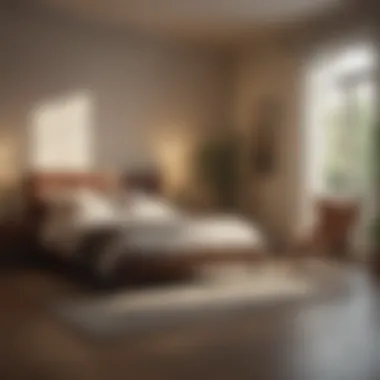

However, one must be cautious with placement. If not set correctly, they can result in uneven lighting patterns, defeating their purpose of enhancing a space.
Best Placement Practices
Understanding best placement practices when installing wall sconces can greatly enhance their effectiveness in your bedroom. Typically, fixtures should be positioned at eye level, particularly for bedside lighting, to ensure they serve their purpose without being harsh on the eyes. Another point to consider is symmetry. Placing sconces in pairs can offer not just a sense of harmony but also balanced light throughout the room. One unique feature of good sconce placement is that it can create soft shadows, adding a touch of intimacy to the atmosphere. However, if poorly located, they may cast unwanted shadows, which can disrupt the cozy vibe.
Table and Floor Lamps
Functionality and Design
Table and floor lamps are the unsung heroes in the lighting game. They’re not just functional; they also serve as artistic pieces that can elevate bedroom decor. Table lamps can sit beside a bed or on a dresser, providing targeted light for reading or other activities, while floor lamps can fill a corner or be placed next to a chair, suggesting a relaxing reading spot. The unique feature of these lamps is their dual-purpose nature, serving both as light sources and as design statements. On the downside, choosing lamps without considering existing decor can lead to visual clutter.
Choosing Between Styles
When it comes to choosing between different styles of lamps, your decision plays a significant role in the room's overall aesthetic. You have sleek modern options or the warm allure of vintage designs to ponder. A mid-century modern table lamp can inject a dose of style while providing light, while a classic Victorian-style lamp might need more careful consideration regarding color and finish. Each unique lamp brings something different to the table—pun intended. Ensure that whatever style you choose complements existing decor while also fulfilling your lighting needs. The disadvantage could be that getting too carried away with stylistic choices may lead to a disjointed look within your space.
Carefully selecting your lighting fixtures—including ceiling lights, wall sconces, and lamps—can make the difference between a well-lit, comfortable bedroom and a space that feels stark or cluttered. Ultimately, the choices should echo your personal style while also meeting the practical needs of your living space.
Energy Efficiency in Bedroom Lighting
In today’s homes, being conscious of energy consumption is more than just a trend; it’s a necessity. Bedroom lighting, often overlooked, plays a significant role in both our daily comfort and the electric bill. By focusing on energy-efficient lighting solutions, one can achieve a balance between aesthetically pleasing decor and cost-effectiveness. With options like LED lights and smart controls, homeowners can tailor their lighting to fit not only their style but also sustainability goals.
Understanding LED Technology
Benefits of LED Lights
LED lights are leading the pack in the journey toward energy-efficient lighting. Their undeniable longevity makes them a popular choice among homeowners. Unlike traditional bulbs, LEDs don't just offer extended life spans; they consume less power when producing light. For example, an LED bulb can produce the same brightness as a traditional incandescent bulb while using only a fraction of the electricity. This results in substantial savings over time, particularly in spaces where lights are used frequently, like bedrooms.
One unique characteristic of LED lights is their versatility. They come in a range of styles, colors, and brightness levels, allowing homeowners to customize their lighting experience. This flexibility supports varied activities—from reading to relaxing—in a single space. Notably, some LEDs are dimmable, granting even further control over ambiance. While the initial cost may be higher compared to incandescent or fluorescent lights, the savings on energy bills and the lifespan of the bulbs more than makeup for that expense.
Life Span and Consumption
The life span of LED lights ranges from 15,000 to 50,000 hours, significantly outpacing traditional incandescent bulbs, which typically last around 1,000 hours. This means fewer replacements over time, reducing waste and contributing to an eco-friendly household.
Moreover, the low energy consumption of LED technology greatly impacts overall energy use in a home. On average, an LED bulb requires about 75-80% less energy than an incandescent bulb to produce the same amount of light. This energy efficiency is crucial for minimizing carbon footprints and enhancing sustainability practices in the bedroom.
Dimmers and Smart Controls
Adjusting Light Levels for Comfort
The ability to adjust light levels is another hallmark of energy efficiency in bedroom lighting. Dimmers allow users to modify brightness, which can be invaluable at different times of the day. Whether it's soft lighting before sleep or brighter light for reading, dimmers provide adaptability. Furthermore, using less light during certain hours can extend bulb life and minimize power consumption.
Homeowners will find that different scenarios benefit from varied lighting intensities. For instance, a dimmer not only sets a calming mood but also adjusts to the changing needs throughout the day. The consistent ability to customize light levels makes this a practical addition to any bedroom.
Integrating Smart Home Technology
As homes become more technologically advanced, integrating smart controls into bedroom lighting has gained traction. Smart bulbs and devices allow homeowners to regulate lighting through smartphones or voice commands, providing convenience and energy savings. Such technology enhances efficiency, enabling users to automate their lighting schedules, turn off lights remotely, or even adjust brightness based on room activity.
Smart lighting also often comes with features that enable monitoring energy usage. Users can track their consumption trends and make real-time adjustments that align with their energy-saving goals. While the upfront investment in smart technology can seem steep, the long-term savings and comfort it offers demonstrate a significant advantage. With these in mind, homeowners not only enhance their lighting experience but also support their eco-conscious efforts as well.
"By being strategic with lighting choices, homeowners can create a space that is both inviting and sustainable."
Integrating Light with Bedroom Decor
In the world of bedroom design, light is not just about visibility; it’s an integral aspect of the overall expression and atmosphere. When you thoughtfully integrate lighting with your bedroom decor, you create more than just a space to sleep;you craft an environment that fosters comfort and tranquility. The interplay between light and decor plays a pivotal role in how one feels in their sanctuary. A well-lit room can change the perception of space, accentuating design elements while also setting the stage for relaxation.
Color Temperature and Mood
Selecting Warm vs. Cool Lighting
When it comes to choosing between warm and cool lighting, context is key. Warm lighting, with its soft yellow tones, creates a cozy ambiance that's ideal for winding down after a long day. This type of light invites a sense of warmth and intimacy, making it a popular option for bedrooms. In contrast, cool lighting, which often leans towards bluish hues, can energize a room, making it feel fresh and awake, though it might not be the top choice when relaxation is the goal.
The unique feature of opting for warm lighting is its ability to mimic the comfort of candlelight or soft sunshine, potentially lowering stress levels and encouraging restful sleep. However, too much warm light can sometimes come off as overly dim, lacking the crispness that’s needed when tackling tasks such as reading or organizing. Thus, selecting the right balance between these temperatures becomes essential for achieving the desired effect.
Effects on Space Perception
Light can manipulate how we perceive a room’s dimensions. Bright, cool light often tricks the eye into seeing more space, making a smaller bedroom feel bigger and airier. This feature is particularly advantageous if your bedroom is on the compact side and you wish to avoid feelings of confinement. Conversely, warm light has a way of wrapping a room in comfort, but might make it feel cozier—sometimes bordering on cramped.
The primary advantage here is that strategic use of lighting can significantly alter the feel of a space based on the desired mood, acting almost like a mood ring for the room itself. However, one must tread lightly; overdoing bright, cool lights can create a sterile or clinical environment, especially in a space meant for relaxation.
Coordination with Color Schemes
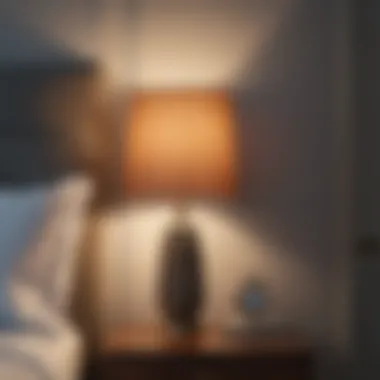
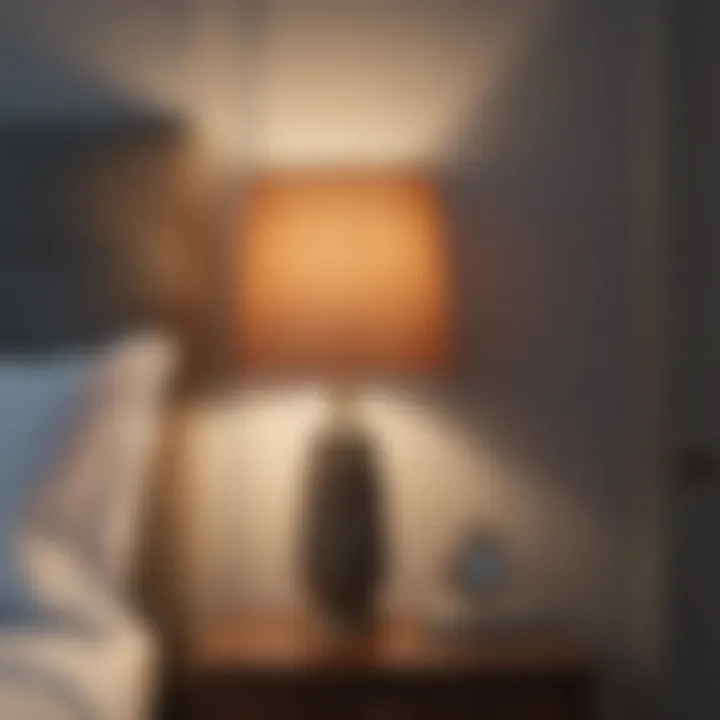
Complementing Wall Colors
Incorporating light that complements wall colors can elevate the design of any bedroom. For instance, pairing warm white lights with soft beige walls can enhance that cozy feeling, making the space feel more inviting. On the flip side, pairing vibrant accent walls with cooler light can really make the colors pop—drawing the eye to details that might have gone unnoticed otherwise.
The distinctive aspect of coordinating lighting with wall colors is how it creates harmony or contrast in design. If a color scheme leans heavily on pastel tones, introducing brighter light might disrupt the gentle feel of the room. Conversely, overly muted lighting can wash out more vibrant wall colors. Finding this balance ultimately contributes to the cohesiveness of your bedroom decor, making it visually appealing and satisfying.
Creating Depth and Interest
Creating depth and visual interest in a space through lighting can truly make a bedroom stand out. Using different types of lighting at various heights—like wall sconces paired with table lamps—can create layers that give the illusion of space. This approach not only adds dimension but also draws the eye across the room, encouraging exploration of its features.
The unique feature of adding layers through light is the ability to guide where a person’s gaze goes in a room. Introducing various sources—ambient, task, and accent—can produce a dance of shadows and highlights that fosters a dynamic atmosphere. Yet, if not carefully curated, too many competing light sources can lead to visual clutter, detracting from the overall tranquil vibe intended for a bedroom.
Strategic Placement of Lighting
Strategic placement of lighting plays a crucial role in transforming a bedroom from a mere sleeping space into a sanctuary of comfort and functionality. Selecting where and how to place your lights can greatly influence the room's ambiance and utility. Well-placed lights not only enhance the aesthetic appeal but also ensure that every corner of the bedroom serves its purpose.
The specific elements to consider include zoning your lighting to create distinct areas suitable for different activities, as well as understanding height and directionality for each light source. This thoughtful approach is beneficial because it allows individuals to tailor their bedroom atmosphere according to their needs—be it relaxation, studying, or preparing for the day. The right placement can enhance the overall mood and make the space feel cohesive.
Zoning Your Bedroom Lights
Defining Areas with Light
Defining areas with light is about segmenting the bedroom into various functional zones through the application of different lighting types. This approach contributes to the overall goal of creating a harmonious environment where each part of the room serves a different purpose. For example, putting brighter lights near the reading nook or desk encourages productivity while a softer glow near the bed fosters relaxation.
The key characteristic of this technique is its adaptability. It's a beneficial choice because it allows for flexibility in how the bedroom is utilized, aligning directly with individual routines and preferences. This zoning can be achieved using a mix of ambient and task lighting, ensuring that all areas are appropriately illuminated without overwhelming the senses.
Yet, a unique feature of defining areas with light is that there needs to be a balance. Too much segmentation can lead to an uninviting feel, making the room appear disjointed. Therefore, one must be careful to ensure that the lighting coordinates harmoniously across zones to maintain visual coherence.
Layering Light Sources
Layering light sources refers to the combination of different types of lighting—ambient, task, and accent—to create a well-rounded illumination scheme. This adds depth and dimension while supporting the overall aesthetic of the space. By blending these light layers, you can manipulate the mood and function of the room effectively.
The key characteristic of layering is versatility. This method is popular because it creates visual interest; for instance, a dimmable ceiling fixture can provide ambient light, a focused desk lamp serves as task lighting, and wall sconces can act as accents. Additionally, this blend helps in adapting to varying activities throughout the day and night.
A unique feature of layering light sources is its capacity to provide a dynamic environment. It allows for adjustments based on the time of day or mood, although one must be mindful of not cluttering the space with too many fixtures, which can lead to an overwhelming and confusing atmosphere.
Height and Directionality
Determining Optimal Heights
Determining optimal heights for light fixtures influences how effectively they illuminate a space. Placing light sources at the right height can enhance visibility while avoiding glare and shadows. For instance, bedside lamps should be positioned to provide sufficient light for reading without straining the eyes, typically around the height of the mattress.
The key characteristic here is function over form. This approach is beneficial as it makes everyday activities like reading or preparing for sleep simpler and more enjoyable. Moreover, because different fixtures have varied designs, understanding the right height helps integrate these elements organically into the bedroom’s layout, enhancing the aesthetic appeal without compromising on functionality.
However, a unique feature of height determination is the risk of mismatched scales. An overly high or low fixture can lead to unintentional hotspots, where light is either lost or overbearing, disrupting the balance in the room.
Adjusting Directions for Function
Adjusting directions for function emphasizes the importance of orienting light to meet specific needs, such as directing a spotlight towards a work area or creating soft, enveloping light around the bed area. This principle aids in optimizing every light source for its intended purpose, ensuring functional satisfaction and enhanced mood.
The key characteristic of this adjustment is its practicality. It’s a beneficial choice because altering the angles of light can dramatically change the room's utilization and highlight certain features. For example, directionally adjustable ceiling lights can ensure focused task lighting exactly where it is needed, like for reading or crafts.
One unique aspect of this tactic lies in its ease of implementation. Many fixtures on the market offer flexibility in direction, although careful consideration should be taken to avoid creating harsh shadows or uneven light patches. This requires continuous assessment as activities within the room change.
"Lighting serves not only to illuminate but to define and refine our experiences within a space."
Finale: Crafting Your Ideal Bedroom Lighting
The journey through bedroom lighting is not just about selecting bulbs and fixtures; it’s about creating a sanctuary that beckons relaxation and nurtures restfulness. This article has carefully explored the various dimensions of indoor lighting, emphasizing that the final choice is deeply personal and reflective of individual lifestyles. Crafting your ideal bedroom lighting should resonate with your taste while fulfilling various functional needs. When harmoniously integrated, the right mix of ambient, task, and accent lighting can magical transform a room.
Reflecting Personal Preferences
Tailoring Solutions to Individual Needs
Choosing lights isn't merely about illuminating the space. It's about sculpturing an atmosphere that aligns with what makes you feel at peace. Personal preferences play a pivotal role here. For example, someone who enjoys reading before bed might prioritize warm bedside task lights that reduce strain while creating coziness. Others might focus on dimmable ceiling fixtures to dramatically shift the vibe from busy daytime to serene evenings.
A key characteristic of tailoring lighting solutions is versatility. This allows you to adapt the lighting as your needs evolve – like switching from a bright reading light to a soft glow for movie nights. This approach not only enhances the functional utility of the space but also allows you to showcase your unique style. It's a robust and mindful choice, especially for individuals wanting to create an inviting space at home, striking a balance between personal expression and day-to-day needs.
However, one unique feature of this customization is that it may sometimes lead to over-complication. Too many choices can be overwhelming, but with careful consideration, this can turn into a delightful endeavor.
Final Considerations for Choice
When it comes to wrapping up your lighting decisions, considering the final elements is crucial. This phase should encapsulate not just the aesthetic but also how the lights interplay with the functions of the room. A critical characteristic of this step is functionality integrated with style. This means your chosen fixtures must serve a purpose while complementing your bedroom decor. For instance, opting for a sleek floor lamp with a statement design can serve as both a reading light and a decorative element.
The unique aspect of final considerations is that they encourage a thorough evaluation of all your choices. Do the lights complement the textures and colors of the room? Are they energy efficient? These questions help in narrowing down options while ensuring informed decisions. While this meticulous approach can be time-consuming, its advantages far outweigh the initial effort. Ultimately, making thoughtful choices culminates in crafting a bedroom that isn't merely a place to sleep but a haven that reflects your personality and nurtures your well-being.
"The best lighting for your bedroom is the one that feels just right for you."
In summary, bedroom lighting goes well beyond the practical. It invites an exploration of comfort, ambiance, and personal taste. Navigate this path wisely, and you'll create a delightful space that resonates on a personal level, reinforcing tranquility and comfort long after the last light is turned off.



